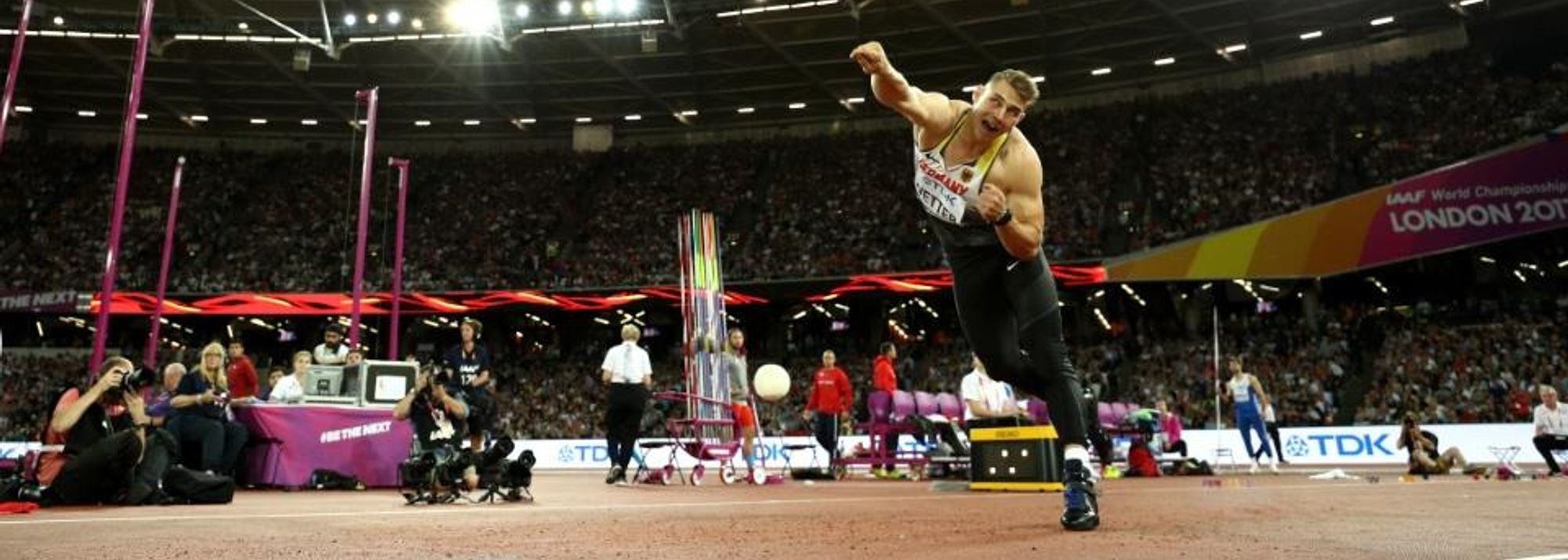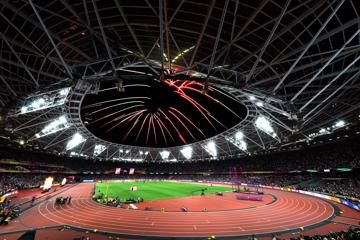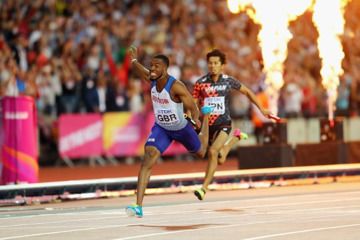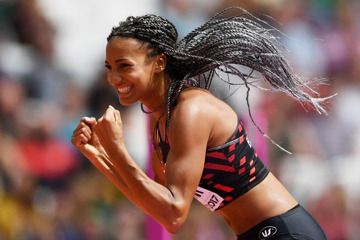Javelin winner Johannes Vetter at the IAAF World Championships London 2017 (© Getty Images)
Our end-of-year review series continues as statisticians A Lennart Julin and Mirko Jalava look back on the best throwing performances of the year.
Men's shot put
The world record turned 27 this summer so one might believe that not much is happening in the event currently, but such a contention couldn’t be more false. Actually, the event at the moment seems to be in one of its most dynamic periods ever.
From 2000 to 2013, the yearly number of 21-metre-plus putters outdoors hovered at about 10, but since 2014 it has been 15, 10, 18 and this year, 22. Driving this silent revolution is a globalisation as the number of nations with 21-metre-plus athletes has increased dramatically: in 2013, the last post-Olympic year, they were just six and in 2015 still just six – but in 2017 there were 16.
At the very top, even the world record looked vulnerable after Ryan Crouser's 2016 international emergence. He started 2017 impressively by consistently surpassing 22 metres and came into the IAAF World Championships London 2017 undefeated with four straight meetings around 22.50m. However, in London Crouser experienced technical problems and finished sixth.
The gold medal went to New Zealand’s Tom Walsh who thrives on big occasions. He set personal bests at the IAAF World Indoor Championships Sopot 2014, IAAF World Championships Beijing 2015 and IAAF World Indoor Championships Portland 2016. He didn’t extend his lifetime best in London, but a 22.14m effort in the qualification was a season’s best and in the final Walsh produced the three longest marks, topped by 22.03m.
There were two new members of the 22-metre club this year: Czech Tomás Stanek and Darrell Hill of the US. The Czech recorded 22.01m twice and Hill, who had finished just 11th in London, shocked everyone at the IAAF Diamond League final in Brussels by improving his personal best by half a metre to 22.44m on his last attempt.
Men’s discus
This event was dominated by the duo of Robert Harting and Piotr Malachowski for several seasons although the 2016 Olympic gold went to Robert’s younger brother Christoph. But 2017 became a kind of changing of the guard as a younger generation of throwers took charge by raising their own games noticeably.
This was evident at the World Championships which, despite an almost windless closed stadium, arguably held the highest standard ever. In the qualification round the cut-off mark for the first time exceeded 63 metres and in the final it took 68 metres to get a medal, which has previously only happened once (1999) at a World Championships.
This exceptional quality was no surprise but rather the logical consequence of the preceding IAAF Diamond League summer. In Oslo five men threw beyond 65 metres, in Stockholm five were beyond 66 metres and in London three surpassed 66 metres. The Stockholm meeting was especially impressive with eight legal throws beyond 67 metres and another 13 beyond 65 metres.
The main contenders on the circuit were Daniel Stahl, Andrius Gudzius, Fedrick Dacres and Philip Milanov and with the exception of Milanov, who missed out in qualification, they also performed well in London.
Gudzius improved his personal best to 69.21m to win by a mere two centimetres over Stahl while Dacres finished fourth behind US sensation Mason Finley who set personal bests in both rounds one and two of the final: 67.07m and 68.03m.
Gudzius also took the IAAF Diamond League title but overall he was 4-4 vs Stahl who in Sollentuna in June surpassed legend Ricky Bruch’s 71.26m national record from 1984 by three centimetres. That 71.29m was the longest throw since 2013 and moved Stahl up to ninth place on the world all-time list.
Men’s hammer
The hammer has for the past three years been the almost exclusive property of Pawel Fajdek. From 2015 to 2017 he registered 34 competitions beyond 80 metres vs three for the rest of the world combined. However, Fajdek has on occasion proved to be vulnerable, most noticeably at the Rio Olympics where he was eliminated in the qualification.
In London one could see that Fajdek hadn’t yet rid his mind of Rio completely but this time he in the end managed to prevail. However, in the qualification it took two throws to get the pre-set standard of 75.50m and in the final he was trailing until the third round.
The only other thrower to reach beyond 80 metres this year was his compatriot Wojciech Nowicki who also inflicted the only loss when winning the Polish title, 80.47m to 78.64m. But in London Nowicki also lost to neutral athlete Valeriy Pronkin.
While Fajdek and Nowicki at age 28 have been around for some years, Pronkin at age 23 belongs to a younger generation that appears ready to begin to replace the establishment throwers such as Dilshod Nazarov and Krisztian Pars. Meanwhile, fourth-placed Frenchman Quentin Bigot is still only 24.
Will he and Pronkin be able to improve further to become true challengers to Fajdek’s supremacy at the 80-metre level? Or should we wait for Hungary’s Bence Halász, who after a very successful junior career, in his first year with the senior implement reached the London final where he finished 10th?
Men’s javelin
Does anyone remember the London Olympics when Keshorn Walcott won at 84.58m and Tero Pitkämäki finished fourth at 82.80m? Now, just five years later in the same arena Walcott threw 10 centimetres less to end up seventh while Pitkämäki, despite improving by more than four meters to 86.94m, had to be content with fifth place.
The past few years have seen a major resurgence and the top standard in 2017 actually was the best ever with nine throwers beyond 88 metres. The previous best was seven; in 2012 just one.
Germans Thomas Röhler and Johannes Vetter are leading this exciting new era. Before 2017 'never-a-bad-throw Röhler' usually had the upper hand as Vetter was more of a hit-or-miss thrower.
But Vetter, two years Röhler’s junior, had obviously worked hard on his consistency when preparing for 2017. Although Röhler won the season opener in Doha with a magnificent 93.90m to move to second on the world all-time list, Vetter came out on top merit-wise thanks to his gold in London and by replacing Röhler as the all-time No.2 after throwing 94.44m in Luzern in July.
That meeting was the pivotal point: Röhler recorded 89.45m but still was almost humiliated by Vetter’s amazing series: 90.75m, 91.06m, 93.06m, 94.44m and 89.50m before passing his final attempt. Especially impressive was that Vetter managed to improve his personal best three more times after hitting his first ever 90-metre throw.
Despite all this, the German duo didn’t have the event all to themselves. At the World Championships Röhler finished fourth behind the Czech duo of Jakub Vadlejch and Petr Frydrych while statistically the Germans were joined in the 90-metre club by compatriot Andreas Hofmann and Cheng Chao-Tsun of Taipei who both produced throws beyond 91 metres at the World University Games.
Women's shot put
In the absence of New Zealand’s Valerie Adams, the clear No.1 athlete in this event for the past ten years, the women’s shot put crown was open for anyone to take in 2017.
The 33-year-old Adams, who gave birth to daughter Kimoana Josephine on 10 October, recently saw her win streak extended to 107 finals between 2006-2014 after the disqualification of Nadzeya Ostapchuk’s results from 2005 until the end of her career in 2012.
Olympic champion Michelle Carter was nowhere near her 2016 level when she produced monster last throws of 20.21m in Portland to take the world indoor title and 20.63m for the Olympic title. The 32-year-old came to London with only a 19.34m season’s best and while not being able to challenge for gold, she earned the bronze with a 19.07m effort, the lowest bronze medal result at the Olympics and World Championships indoors and outdoors combined since Helsinki 2005.
Instead it was seasoned Chinese 28-year-old Gong Lijiao at the top of the shot put during the summer of 2017, who won each of her nine outdoor competitions. She was the only thrower to surpass 20 metres this season with a 20.11m world leader in Böhmenkirch, her last competition before London. At the World Championships she took the lead from the first round and kept it through the competition. Her final two throws of 19.94m and 19.89m were much farther than silver medallist Anita Márton’s 19.49m which came with her last throw. Gong finally struck gold after winning two silver and five bronze from earlier major championships. She also won the IAAF Diamond League title.
Women’s discus
Sandra Perkovic enjoyed another near perfect season at the top of the women’s discus.
The 27-year-old Croatian has won nearly everything since she was crowned the Olympic champion in 2012 in London. The only loss in major championships in this period came at IAAF World Championships Beijing 2015, where Cuban Denia Caballero hit a big opening throw of 69.28m to win the gold.
In 2017 Perkovic started strong, hurling her discus to a 70.23m world lead in Split at the National Winter Championships, the first women’s 70-metre discus result in the month of February. The Croatian won nine out of her 11 finals with two narrow losses against Cuban Yaimé Pérez in Stockholm and Sotteville. The last competition before the IAAF World Championships in London in Bellinzona worked as the best possible dress rehearsal. Perkovic threw a 71.41m national record and world lead in round two with another 70-metre throw of 70.05m in the final round. The last time a throw this long was produced was more than 25 years ago, in Beijing on 14 March 1992 where Xiao Yanling set a 71.68m Asian record.
In London Perkovic led from round one and produced four throws beyond 69 metres and two beyond 70. Her 70.31m winning mark was only the third time a World Championships gold was awarded following a 70-metre result.
There was a huge throw by 2009 world champion Dani Stevens in the last round in London. The 29-year-old Australian added 1.65m to her previous best of 67.99m set in 2014 with a 69.64m Oceania record. Olympic silver medallist Mélina Robert-Michon of France won the bronze with 66.21m ahead of Yaimé Perez (64.82m), the only athlete to be able to beat Perkovic in 2017. Perkovic also won the IAAF Diamond League crown.
Women’s hammer
There was really no question about who would win the women’s hammer title in London.
In her last competition before the World Championships, Poland’s Anita Wlodarczyk, the world record-holder with 82.98m from 2016, hit five consecutive 80-metre throws before fouling her last attempt, finishing the competition with 82.87m, the second longest throw of all time. The Pole won all of her 12 finals during the summer and grabbed her third world title in London despite some early problems in the competition. She also won the IAAF Hammer Throw Challenge.
Wlodarczyk only managed 71.94m for sixth place after the first three rounds, but her fourth-round effort of 77.39m would have been enough for gold before her farthest throw of 77.90 coming with the next throw. The early leader in the competition was Chinese Wang Zheng, whose best placings at the IAAF World Championships were fourth in 2013 and fifth in 2015. The 30-year-old threw 75.94m in round two and 75.98m with her last effort to win her first major medal, a silver.
Poland was awarded two medals in London as 23-year-old Malwina Kopron took big strides towards the top during the 2017 season. Kopron had thrown 75.11m before London and won the qualification with 74.97m at the World Championships before winning the bronze with 74.76m in the final.
Zhang Wenxiu made a fierce attack at another medal, but the 31-year-old finished her major championships career in fourth place with 74.53m. The Chinese won a total of seven medals from Olympics and World Championships combined during her career and went on to win the National Games in September with a 75.48m season’s best. Kopron won the World University Games in Taipei with a 76.85m personal best later in August.
Women’s javelin
Croatia’s Sara Kolak was crowned the Olympic champion in 2016 and her 2017 season made her the favourite heading into the World Championships.
A 68.43m world lead and national record in Lausanne in July followed by the European under-23 title in Bydgoszcz, her last competition before London, underlined her favourite’s status.
World record-holder Barbora Špotáková was also in good form in 2017, arriving at the World Championships after a 68.26m season’s best at the IAAF Diamond League meeting in London. While the Chinese athletes were strong at the 2015 World Championships with second and fifth place finishes, they did not do well at the 2016 Olympic Games. In 2017 they were better with 24-year-old Liu Shiying, who did not make the final in Rio last year, throwing a 66.47m Asian record in Kawasaki in May.
Surprisingly it was Lu Huihui, the silver medallist from 2015, who unleashed a monstrous 67.59m Asian record in the first round of the qualification in London. The 28-year-old Lu had come to London with only a modest 62.07m season’s best. In the final the throwers were not able to reach Lu’s big mark and quite surprisingly Špotáková’s second-round effort of 66.76m was enough for gold. With this win, the 36-year-old Czech became only the fourth athlete in the history of the World Championships to have spans of 10 years or more between titles.
The Chinese did well in the final, too. Li Lingwei took silver with a personal best of 66.25m while Lu took the bronze with 65.26m. Kolak meanwhile faded to fourth with 64.95m. Špotáková also won the IAAF Diamond League title.
Mirko Jalava (women’s events) and A Lennart Julin (men’s events) for the IAAF







